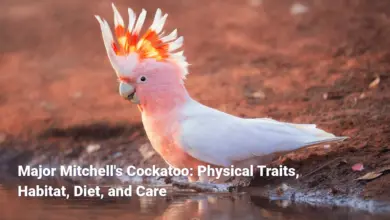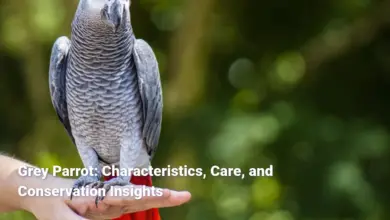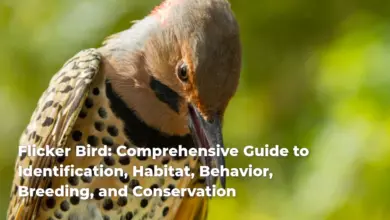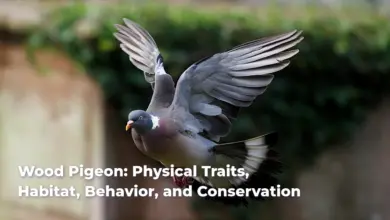Goldcrest: Identification, Habitat, Diet, and Conservation
The goldcrest (Regulus regulus) stands out as one of the most enchanting creatures of the avian world, particularly in Europe. Renowned for its diminutive size measuring only about 8.5 to 9.5 centimeters in length it has captured the fascination of ornithologists and birdwatchers alike. Despite its small stature, weighing a mere 4.5 to 7 grams, the goldcrest is a powerhouse of personality and adaptability. With its cheerful demeanor and lively presence, it can often be seen flitting among tree branches, a bright flash of color against the green foliage. The goldcrest’s striking appearance, coupled with its unique behaviors, makes it an unforgettable subject of study.
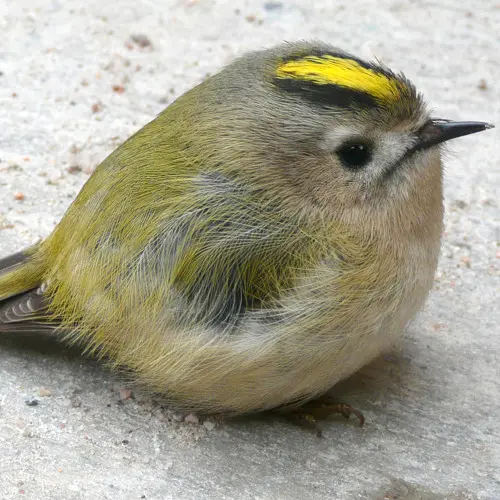
In Europe, this tiny bird is ubiquitous, often found in coniferous forests, mixed woodlands, and even urban gardens where conifers may thrive. Its adaptability to different environments, combined with its physical characteristics, allows it to thrive in a variety of habitats. Seasonally, the goldcrest’s presence can change as it migrates to avoid harsh winter conditions, showing a clever strategic response to the challenges posed by its natural environment. This article will explore various facets of the goldcrest’s life, from its physical traits and coloration to its feeding habits, reproductive behaviors, and conservation status, ultimately highlighting its significance in our ecosystems and culture.
Identification of Goldcrest
Identifying the goldcrest is an enchanting journey into the world of ornithology. This little bird, often lost amongst the leaves, can be recognized not just by its size but by its striking color patterns and dynamic behavior. Picture a tiny jewel darting amidst the greenery; its olive-green feathers blend seamlessly with the forest canopy, yet it carries a crown of color that sets it apart. The males don a brilliant splash of bright yellow with a striking orange center in their crown, while the females feature a wholly yellow crown.
To an untrained eye, the goldcrest may seem just another small songbird, but its defining characteristics make it stand out. Apart from its head’s vibrant colors, the upper parts boast olive-green feathers, contrasting beautifully with the buff-white underbelly. Two prominent white wing bars add to its charm, resembling delicate brush strokes against its darker wing patches. When observing its face, one cannot help but notice its innocent expression, accentuated by dark, round eyes. An easily overlooked but critical aspect of its identification is its slender, pointed bill, which is perfectly adapted for foraging insects hidden in tree bark and foliage.
In summary, the goldcrest is an emblem of nature’s artistry an intricate design of colors and form. Its small size, coupled with its distinctive crown coloration, and its lively actions in the treetops, make the goldcrest not just a bird to identify but a delightful experience for anyone fortunate enough to encounter it.
Physical Characteristics
The physical characteristics of the goldcrest embody both elegance and functionality, with every feature serving a specific purpose that contributes to its survival in various habitats. A perfect microcosm of nature’s design, its small size averaging 8-9 centimeters renders it one of the smallest birds in Europe, evoking the image of a nimble sprite flitting through the branches. This petite stature is crucial, allowing it to access food sources that larger birds cannot reach, and it aids in evading predators.
In terms of coloration, the presence of the goldcrest’s crown is its defining feature. Males, adorned with a vibrant yellow stripe accented by an orange band, often attract the attention of birdwatchers and make for striking images against the lush green backdrop of forests. Meanwhile, the females exhibit a more subdued yellow crown without the orange highlight, representing a softer elegance. Both genders share the olive-green upper parts that blend effortlessly with the foliage an exquisite example of nature’s camouflage intended to thwart predators and enhance their foraging success.
Moreover, juvenile goldcrests resemble adults but exhibit a duller appearance, lacking the vibrant crown markings of their parents. This differentiation not only serves a purpose in sexual dimorphism but also is a strategy for survival, as less colorful juveniles are less likely to attract attention from predators. Their thin and pointed bills are perfectly adapted for probing into crevices of tree bark, making them effective foragers. The quick, whirring flight pattern, marked by sudden direction changes, allows goldcrests to navigate through dense vegetation skillfully, enhancing their agility and evasiveness.
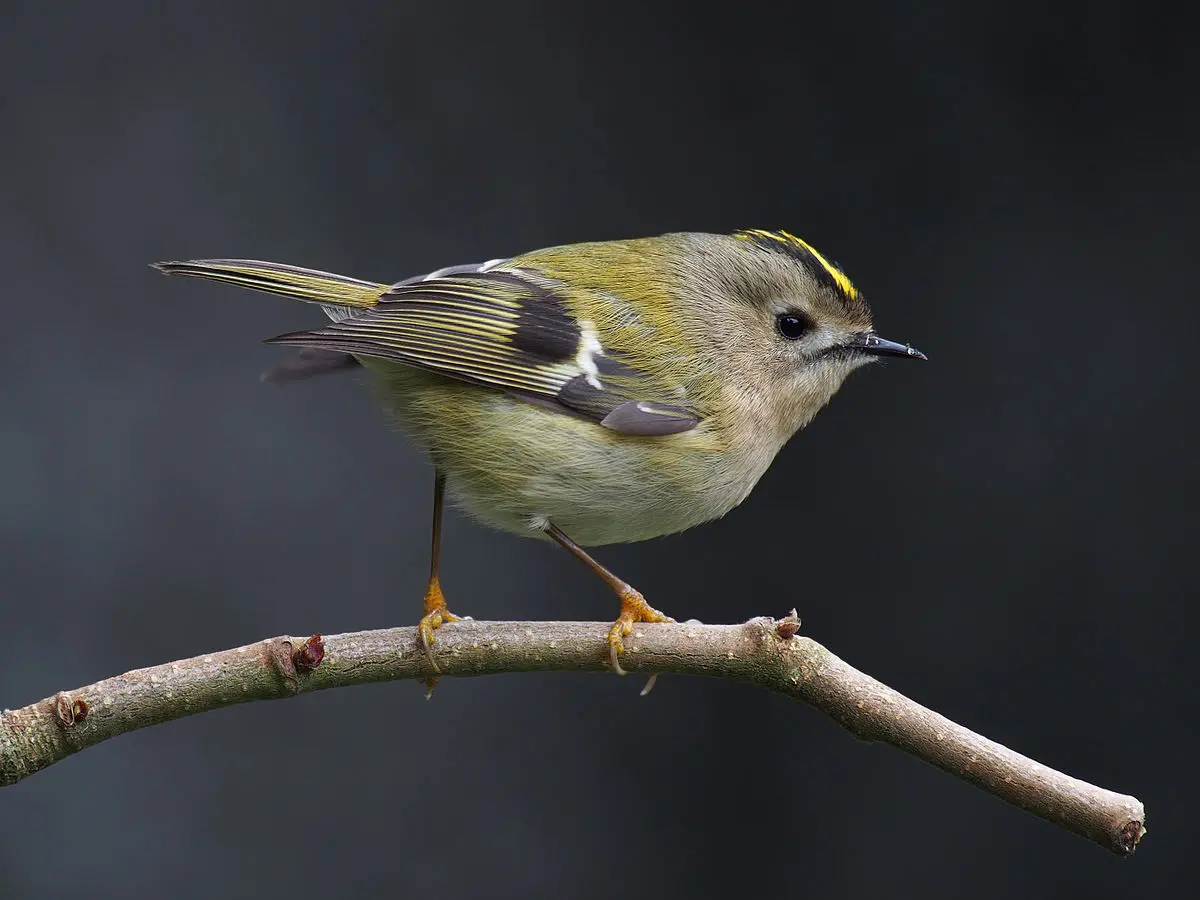
In summary, the physical characteristics of the goldcrest its petite size, distinct coloration, and specialized adaptations create a fascinating profile that exemplifies the beauty and intricacies of the natural world. This remarkable species is not just a feast for the eyes but a study in evolutionary prowess, symbolizing resilience and ingenuity.
Coloration and Markings
The coloration and markings of the goldcrest are nothing short of artistic, blending to create an avian masterpiece that reflects beauty and function. This diminutive bird showcases a palette primarily dominated by earth tones, allowing it to seamlessly blend into its woodland surroundings. When the light catches it just right, however, the vibrant colors emerge, sparking the imagination of bird enthusiasts and casual observers alike.
The male goldcrest is adorned with a flamboyant crown, comprised of a bright yellow stripe and an orange center that resembles a small crown jewel. This feature serves not only as an identifier but also plays a crucial role during courtship, helping males attract mates and establish dominance within their territory. In contrast, females display a more understated yellow crown without the orange accents, a subtlety that allows the species to maintain a level of sexual dimorphism that enhances identification through visual cues.
Beyond the crown, the body’s olive-green hues provide effective camouflage against the forest’s dappled shadows. The soft underparts, which are buff-white, contrast elegantly with the darker olive tones, creating an appearance that changes with the seasons and the surrounding foliage. The two white wing bars serve as striking accents against the dark wing patches, capturing attention when the goldcrest takes flight. Each of these features is not merely decorative they serve a purpose in their ecosystem, contributing to predator evasion and mate attraction.
The goldcrest’s face, characterized by its plain yet expressive appearance, features striking dark eyes that stand out against the lighter shades. This contrast enhances its innocent yet alert expression a reminder that even the smallest beings in nature have remarkable stories to tell. Juvenile birds lack the vividly colored crowns of adults, showcasing a drabber palette that aids in their survival as they learn to navigate the complexities of their environment.
In conclusion, the goldcrest is a captivating example of nature’s artistry, presenting a striking interplay of colors and markings that fulfill important biological functions. Its vibrant crown, thorough camouflage, and unique facial features not only enhance its beauty but also reflect its adaptations to the environment, illustrating how nature’s design often encompasses both form and function.
Habitat of Goldcrest
The goldcrest (Regulus regulus) predominantly thrives in environments that offer abundant resources and the necessary cover for nesting. Its preferred habitats are characterized by specific vegetation types, primarily coniferous forests rich in dense foliage, which create a natural setting ideal for foraging and protection. The intricacy of these environments caters to its needs, fostering its tiny body and energetic lifestyle.
Goldcrests are often found in coniferous forests dotted with spruce and fir trees. These environments provide not just food but also shelter, making them perfect for breeding and rearing young. However, the adaptability of goldcrests extends beyond pure woodlands. They are frequently spotted in mixed woodlands, where deciduous trees accompany conifers, offering a varied habitat that supports a diverse insect population crucial to their diet.
Moreover, urban gardens and parks featuring conifer trees play a significant role in the distribution of goldcrests. These adapted settings allow the birds to coexist with human activity, showcasing their flexibility in habitat preferences. In winter, especially during severe weather conditions, goldcrests may seek refuge in undergrowth and scrub-like areas where they can find warmth and cover.
Goldcrests’ habit of remaining close to the ground amidst dense foliage is a behavioral adaptation, allowing them to retain warmth during colder months. This habitat choice reflects a unique interaction between their physical adaptations and behavioral strategies, showcasing their keen ability to navigate shifts in their environment.
The goldcrest’s seasonal patterns demonstrate its connection to specific habitats, as populations from colder regions migrate southward to escape harsh winters. This migratory behavior reinforces the importance of suitable environments for both breeding and wintering, urging the need for conservation efforts to protect essential habitats that support the life cycles of these small yet captivating birds.
Preferred Environments
Goldcrests are creatures that thrive best in specific preferred environments that provide them with ample shelter, food, and suitable nesting sites. Observing them in their natural habitat is akin to witnessing nature’s finesse as they flit from branch to branch, always on the move.
- Coniferous Forests: Goldcrests favor dense coniferous forests, characterized by a predominant presence of spruce, fir, and pine trees. Within these environments, the texture of the foliage offers countless nooks and crannies where insects thrive, making it an ideal foraging ground. The thick branches provide nesting sites that are safe from larger predators, allowing for successful reproduction.
- Mixed Woodlands: In addition to pure coniferous habitats, goldcrests adapt remarkably well to mixed woodlands that comprise a blend of coniferous and deciduous trees. This environment enhances their dietary options, providing a broader range of insects to forage on. The diversity present in these habitats ensures that goldcrests can find suitable food sources throughout different seasons.
- Urban Gardens and Parks: Surprisingly, these tiny birds have also made homes in urban gardens and parks, especially in those with conifer trees. The availability of food and the shelter that these trees provide allow goldcrests to thrive in suburban settings, demonstrating their adaptability in coexisting alongside human developments.
- Undergrowth and Scrub-Like Areas: During the harsh winter months, especially when food availability is limited, goldcrests tend to seek refuge in undergrowth and shrubs. This behavior not only helps them retain warmth but also allows them access to insects lurking in the ground cover. Their innate ability to find shelter in thickets and dense vegetation reveals their adaptability to survive in varying conditions.
In conclusion, the goldcrest’s preferred environments reflect its need for security and sustenance. Its remarkable adaptability to both natural and urban settings illustrates the importance of preserving diverse habitats to ensure that these enchanting birds continue to find their homes, whether in the heart of a forest or a suburban garden.
Distribution in Europe
The distribution of goldcrests across Europe is a testament to their adaptability and resilience. These tiny yet energetic birds can be found from the frosty northern reaches of Scandinavia, through the picturesque expanse of the British Isles, across mainland Europe, extending down to the sun-drenched regions of southern Spain and Portugal. This wide geographical range underscores their ability to thrive in various environments as they migrate and expand their activity to areas suited for their needs.
Considered a common species across the British Isles, they readily adapt to local conditions, demonstrating notable intelligence and resourcefulness. Their presence in both urban and rural settings emphasizes their ability to coexist with human activities while maintaining their natural habits. Throughout the breeding season, goldcrests stake out their territories in forests and woodlands, constructing nests that are well-hidden within the branches, thus avoiding detection from potential predators.
Interestingly, while many goldcrests remain stationary within their preferred habitats during the breeding season, populations inhabiting colder northern regions often take to migration, journeying southward to escape the rigors of winter. This seasonal shift can lead to occasional mass migrations, where these tiny birds travel in flocks, displaying cooperative behavior that enhances their chances of survival against the elements.
Research has tracked these migratory patterns, revealing that goldcrests often utilize geographical features during their journeys. Understanding the distribution of this species highlights the critical importance of habitat conservation not merely for breeding sites but also for migration routes that are vital for their survival throughout different phases of their life cycle.
Overall, the goldcrest’s distribution in Europe reflects an intricate relationship with its environment. Their adaptability, migratory patterns, and breeding success underline the need to preserve diverse habitats, ensuring that these delightful birds continue to grace the skies of Europe for generations to come.
Diet and Feeding Habits
The diet of the goldcrest (Regulus regulus) is primarily insectivorous, making it an energetic and vital forager in its environment. Much like a skilled acrobat, the goldcrest maneuvers through the branches, its small size enabling it to access food sources that larger birds cannot. This unique foraging behavior is not just a means of sustenance but also a demonstration of the bird’s adaptability to its environment.
Their primary food sources consist of small invertebrates, such as tiny insects, spiders, and larvae. Goldcrests have a particular affinity for aphids, moth eggs, caterpillars, and beetles, which are abundant in their preferred habitats. This reliance on insects is particularly vital during the breeding season, as feeding altricial chicks requires a protein-rich diet that supports their rapid growth. When food availability is at its peak, these birds engage in acrobatic foraging, often hovering or even foraging upside down to reach delicate insects hidden beneath leaves or inside bark crevices.
In the winter months, as food becomes scarce, their diet may diversify to include seeds and berries, demonstrating their remarkable ability to adapt. Survival becomes especially critical during harsh weather, with goldcrests needing nearly continuous access to food. Captivatingly, research has shown that under such conditions, unsettlingly low energy levels mean these birds struggle to survive if they do not feed within every hour of daylight.
Birdwatchers often can attract goldcrests to gardens by providing food rich in protein, such as suet mixed with insects and mealworms. These mimicked natural food sources serve as an irresistible invitation, allowing enthusiasts to observe these lively birds up close and appreciate the nuances of their dynamic feeding habits.
In closing, the goldcrest’s diet and feeding habits exemplify nature’s balance of energy and survival. Their insectivorous tendency and adaptability to varying foods during different seasons ensure not only their survival but their success in diverse habitats, making them an essential part of the ecological fabric.
Food Sources
Goldcrests predominantly dine on a variety of small invertebrates that make up the essential components of their diet. Their foraging techniques reflect a sophisticated mastery of their environment. Below are the primary types of food sources that craft the goldcrest’s diet:
- Insects:
- Aphids: Goldcrests show a notable preference for these small, soft-bodied insects, which are abundant in coniferous forests.
- Spiders: These arachnids form a significant part of the goldcrest’s diet, providing essential protein.
- Larvae: Such as caterpillars, these provide a rich energy source crucial for breeding females.
- Other Invertebrates:
- Moth Eggs: These eggs present another easily accessible food source during the breeding season.
- Ants and Beetles: Although less frequently targeted, these insects occasionally supplement the goldcrest’s diet, especially when other food types are limited.
- Winter Alternatives:
- Seeds: During winter months, goldcrests become opportunistic feeders, consuming seeds from various plants.
- Berries: When insects are scarce, berries offer necessary sugars and vitamins, aiding their survival through colder months.
This dynamic diet reflects the goldcrest’s adaptability, enabling it to forage effectively even as food availability fluctuates with the seasons. During the breeding season, an increased caloric intake is vital to ensure both adults and chicks receive the nutrition they require. The role of goldcrests as insectivores also positions them as valuable contributors to their ecosystems, helping to control insect populations.
In conclusion, the food sources of the goldcrest reveal not just what these fascinating birds eat, but how intricately they are woven into the fabric of their habitats. Their ability to adapt to changing food supplies and environments showcases their resilience and highlights their ecological significance.
Foraging Techniques
Foraging is an artful dance performed by the goldcrest in their quest for food, and their techniques exhibit creativity, agility, and skill. As expert foragers, these tiny birds employ a variety of methods, adjusting their techniques according to prey availability and environmental conditions. Here are the key aspects of their foraging behavior:
- Acrobatic Maneuvers: Goldcrests are renowned for their energetic and acrobatic foraging style. They navigate through branches, flitting quickly from one to another, often hovering briefly to inspect the area for hidden insects. Their agility allows them to reach food sources in otherwise inaccessible locations.
- Upside-Down Foraging: One of the remarkable features of goldcrest foraging is their propensity to forage upside down. This unique behavior enables them to probe under leaves and into the nooks and crannies of tree bark, extracting small insects and spiders that might go unnoticed by other birds.
- Rapid Movement: The swiftness with which goldcrests move between branches is optimal for locating food. Their rapid wingbeats create a whirring sound as they dart about, making them somewhat elusive. This quick movement aids in both food acquisition and evading potential threats.
- Ground Foraging: While goldcrests primarily forage in the trees, they are also known to scavenge on the ground, especially during the winter months when they search for seeds and insects that have fallen to the soil. This adaptability further reflects their resourcefulness in different seasons and conditions.
- Food Storage: Interestingly, goldcrests are capable of storing food, hiding seeds for later consumption, indicating a level of intelligence that allows them to plan for food shortages, thereby increasing their chances of survival during lean periods.
In conclusion, the foraging techniques of the goldcrest illustrate a blend of instinctual skill and adaptability, empowering this tiny avian marvel to thrive in a variety of habitats. Their methods underscore their role in the ecosystem as both foragers and controllers of insect populations, highlighting their importance within the food web and natural balance.
Breeding and Reproduction
The breeding behaviors of goldcrests showcase the remarkable adaptations that these tiny birds employ to ensure their continuation. The heights they reach in the realm of reproduction reflect their resilience and resourcefulness in the face of environmental challenges. Nesting generally takes place between late April and June, with goldcrests forming monogamous pairs for the breeding season.
During courtship, males attract females through a combination of song and visual displays, showcasing their vibrant crests to flaunt their vitality. The construction of nests falls predominantly to the female, who builds a spherical nest using moss, lichen, and other natural materials and decorates it from the soft underbelly of feathers to offer warmth and protection for its future occupants. These nests are typically placed in the outer branches of conifer trees, where they can be well-concealed from predators, creating a safe haven for raising young.
Couples generally produce two broods in a breeding season, with clutch sizes ranging from 8 to 12 eggs. The incubation period is a critical phase, lasting around 16 to 19 days during which the female incubates the eggs primarily. Once hatched, the chicks are altricial, relying entirely on their parents for sustenance and protection. Both male and female goldcrests share the responsibility of feeding the chicks, showcasing a strong parental bond that supports the chicks’ development.
Remarkably, goldcrests often begin preparations for the next brood while still caring for the first, allowing them to maximize their reproductive potential during seasons of ample food availability. This prolific breeding strategy is a testimony to their adaptability and demonstrates how a combination of environmental conditions and food sources can dictate their reproductive behaviors.
In summary, the breeding and reproduction of goldcrests magnify their intricate biological strategies. The collaborative nature of parenting, the craftsmanship of nest building, and the ability to produce multiple broods within a season highlight the adaptations that enable these small wonders of nature to thrive and survive across their habitats.
Nesting Behavior
Goldcrests demonstrate fascinating nesting behaviors that highlight their ingenuity and adaptability in the wild. The nesting process is a meticulous undertaking that reflects the challenges of avian survival, with each aspect carefully crafted to ensure the safety and health of the young. Typically, goldcrest nests are constructed high within the branches of conifer trees, positioning them away from ground predators and offering protection within the dense foliage.
The female goldcrest assumes the primary responsibility for nest construction, gathering an array of materials that serve both structural and insulation purposes. Building nests that are spherical in shape, she uses a combination of natural materials such as lichen, moss, and spider webs, which not only bind together but also provide essential warmth. The lining of the nest often includes feathers, which further enhances insulation and comfort for the chicks as they develop.
Goldcrests prefer to nest in areas where dense vegetation is dominant, as this foliage acts as a protective cloak for the birds. The choice of high branches also minimizes the risk of detection by predators, such as larger birds or land-based carnivores. The breeding season typically spans from late April to July, during which the female lays a clutch of 10-12 eggs, characterized by a pale, speckled appearance.
A remarkable aspect of their nesting behavior is that goldcrests can raise multiple broods during a single breeding season. This means that while a pair is still caring for their first brood, they may already begin to prepare for the next, another testament to their adaptability and resilience against environmental challenges. Typically, after hatching, the chicks remain hidden in the nest for 17 to 22 days, relying on their parents for protective feeding and warmth until they fledge.
In summary, the nesting behavior of goldcrests is a beautifully complex process that reflects their unique adaptations and resourcefulness. Their ability to construct secure nests utilizing available materials showcases their keen survival instincts, ensuring that they continue to thrive within their diverse habitats.
Mating Habits
The mating habits of goldcrests inspire intrigue, marked by elaborate courtship displays and strong partner bonds that enhance their survival. As monogamous birds, goldcrests form pair bonds during the breeding season, typically starting their courtship rituals in late April. Males initiate courtship by singing melodically, utilizing their vibrant crowns as visual signals to attract females allure punctuated by their energetic displays.
The display of their colorful crests serves not only as a means of attracting a mate but is also a way of establishing territory among competing males. During these displays, males often flutter and hover, choosing prominent perches within their territory to showcase both their colors and songs, designed to captivate potential mates as well as deter rival males. This displays boldness, strength, and genetic quality key factors that influence female choice.
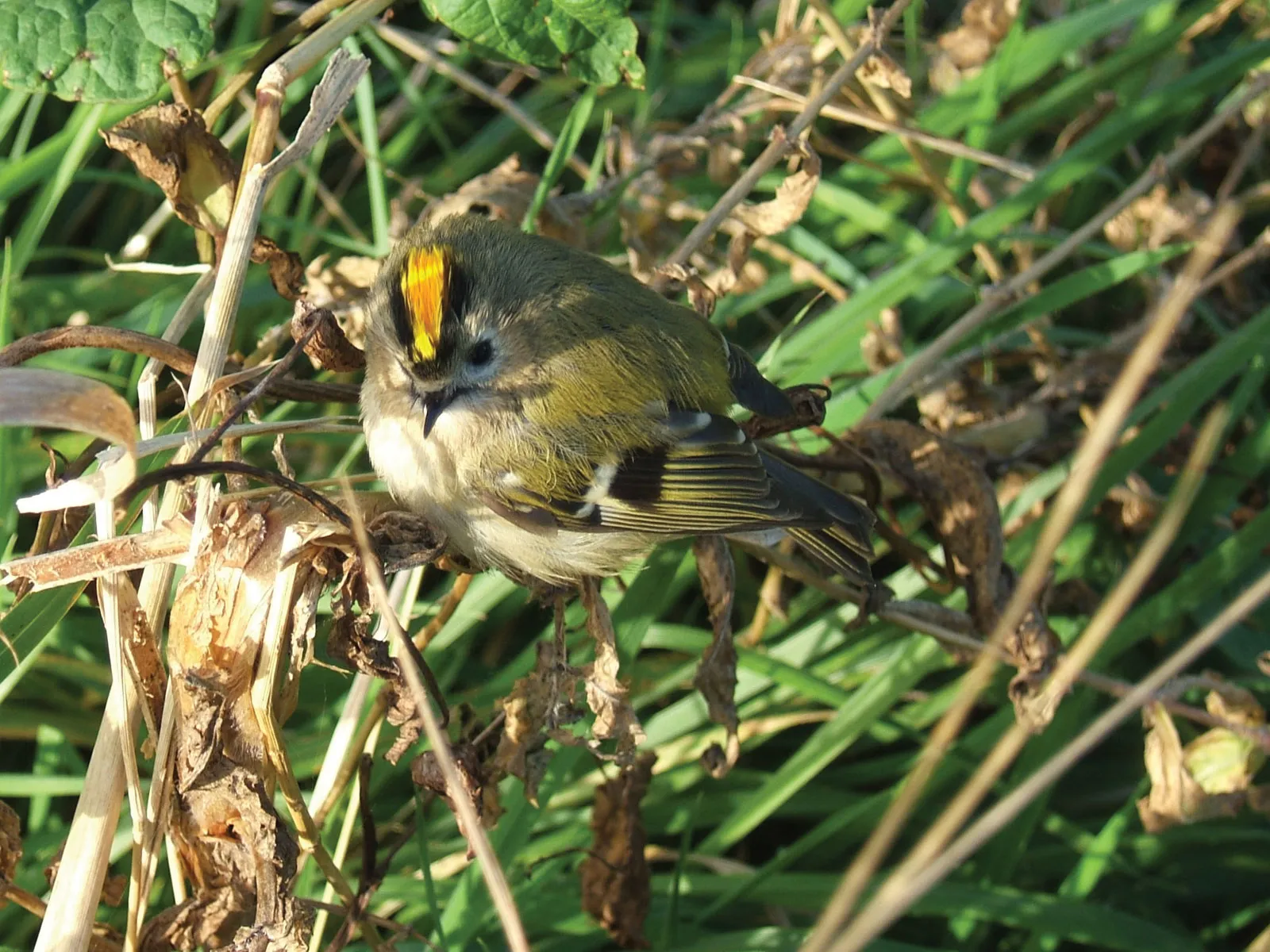
Once a pair is formed, the bond strengthens as they cooperate in nest construction and subsequent chick-rearing. Despite the female primarily building the nest, the involvement of males is evident in their role of provisioning food, sustaining the female during incubation, and feeding the chicks later. This collaborative approach enhances the successful rearing of young in a species with a significant ecological role.
The enchanting aspect of goldcrest mating habits is not just in the initial courtship but also in their remarkable reproductive strategy. Many pairs successfully raise two broods each season, with overlapping care for fledglings. While the first brood may have just left the nest, the parents can begin preparing for a second clutch maximizing their reproductive output in environments where food is plentiful.
In conclusion, the mating habits of goldcrests embody nature’s charm, emphasizing the dynamic interplay between attraction, cooperation, and survival. Through vocal displays, striking appearances, and shared parenting, goldcrests offer a glimpse into the intricate behaviors that shape avian life and contribute to the richness of biodiversity.
Migration Patterns
The goldcrest is known for its intriguing migration patterns, characterized by seasonal movements that correlate with changing environmental conditions. These tiny birds are primarily migratory, requiring strategic navigation between breeding and wintering grounds. Intricately linked to moments of food availability and climate, these patterns reveal essential behaviors for survival amidst the changing seasons.
As the breeding season unfolds, goldcrests establish territories primarily within their coniferous forest habitats across Europe. During the late summer to early autumn months, when colder weather begins to signal the approach of winter, those goldcrests located in the northern regions typically migrate southward. The flexibility of their migratory patterns ensures their survival in regions with harsh winter conditions, reflecting the resilience of the species.
The timing of migration aligns closely with external environmental cues, including decreasing temperatures and diminished daylight, which invigorate their instinctive behaviors. Research indicates that variations in food availability play key roles in triggering these migration events, compelling goldcrests to seek out habitats rife with sustenance.
Interestingly, migration is not uniform across populations; some goldcrests undertake extensive journeys while others remain relatively localized, depending on their habitat and natural resources available. For example, populations residing in southern Europe may elect to stay put during winter months, while northern populations often engage in longer migrations toward milder climates.
Additional studies, including citizen science projects, have contributed valuable data to our understanding of goldcrest migration routes. These insights highlight the potential impact of environmental changes on migratory behavior, underscoring the importance of maintaining critical habitats along migratory pathways to ensure their successful journey.
In summary, the migration patterns of goldcrests illustrate their connection to ecological dynamics and climate variability. Their seasonal movements reveal intricate adaptations that facilitate their survival, emphasizing the importance of conserving habitats that support their migratory journeys and breeding success.
Seasonal Movements
Seasonal movements are a defining characteristic of goldcrests, influencing their distribution and behaviors throughout the year. These small birds exhibit precise migration patterns dictated by changes in environmental conditions, particularly during the transition from breeding to wintering habitats. Understanding these movements offers insights into their survival strategies.
In the spring months, typically around late March and early April, goldcrests return to their breeding grounds in coniferous and mixed forests. They establish territories where they court and breed in harmonious surroundings. As the summer fades and days grow shorter, preparations for winter begin. As autumn approaches, deteriorating weather conditions and decreasing food availability prompt many northern populations to migrate southward, seeking refuge in warmer climates.
During migration, goldcrests may assemble in loose flocks, providing energy efficiency against harsh winds. The journey can vary in distance from local movements to more extensive migrations, depending on environmental triggers and individual adaptations. This variability showcases the bird’s resilience and ability to navigate fluctuating climates.
Furthermore, the timing of migration is closely tied to environmental cues temperature drops and reduced daylight hours catalyze their instinctual responses. Captivatingly, some goldcrests remain sedentary in regions where winter conditions are soft, illustrating a nuanced interplay between habitat and survival.
In conclusion, goldcrests’ seasonal movements reveal inherent strategies formed through natural selection. Their responses to climatic shifts and ecological food availability underline the importance of habitat conservation, ensuring these beguiling birds endure against the relentless pressures of changing environments.
Impact of Weather on Migration
Weather profoundly influences the migration patterns of goldcrests, acting as a crucial determinant in their seasonal movements. Various environmental factors, such as temperature fluctuations, precipitation levels, and wind conditions, shape their migratory behavior throughout the year.
- Temperature Fluctuations: The onset of colder weather conditions often initiates the migration of goldcrests. As temperatures drop, these birds instinctively sense the need to travel to warmer climates, where food sources remain abundant. The urgency of migration is palpable, driven by the instinctual need to survive harsh winters.
- Precipitation Levels: Heavy rainfall or storms can disrupt a goldcrest’s ability to successfully migrate. Adverse weather conditions can lead to delays, forcing them to seek temporary shelter until conditions improve. In these cases, individual birds or flocks may adjust their migration timing, sometimes returning to breeding grounds if necessary.
- Wind Conditions: Favorable or adverse wind conditions can significantly impact the efficiency of goldcrest migration. Opting for tailwinds can boost their journey, covering greater distances with less energy expenditure. Conversely, strong headwinds may deter them, encouraging birds to seek local food sources and postpone migration.
- Climate Change Consequences: As climate conditions continue to shift due to global warming, the predictability of seasonal movements may also be affected. Weather patterns may become more erratic, resulting in delayed migrations or altered timing for breeding and nesting. This adaptability showcases the resilience of goldcrests, yet also highlights their vulnerability in the face of rapidly evolving climatic challenges.
In conclusion, the influence of weather on goldcrest migration encapsulates the relationship between ecological factors and behavioral adaptation. Understanding this connection underscores the importance of habitat conservation in a changing climate, helping ensure the survival of these vital avian species.
Behavior and Social Structure
The behaviors and social structures of goldcrests illustrate the complexities of avian life. This small species exhibits a fascinating range of social interactions, particularly noteworthy given their tiny size. The contextual dynamics that dictate their behavior provide valuable insights into how they navigate their environments, foraging, mating, and raising their young.
- Daily Activity Patterns: Goldcrests are diurnal in nature, engaging in various activities throughout the day. Their high-energy lifestyle includes foraging for food, singing, establishing territories, and engaging in courtship displays. The timing of these activities reflects their need to maximize the limited daylight hours available for feeding and socializing.
- Group Dynamics: While goldcrests are primarily solitary during breeding seasons, outside of these months, they often form loose flocks. In winter months, they congregate, roosting together to conserve heat. This social behavior aids survival, highlighting their ability to adapt to environmental pressures. The social structure within these flocks also facilitates cooperative foraging, as individuals leverage shared knowledge to locate food sources, thus enhancing survival chances.
- Territorial Behavior: During the breeding season, males exhibit territorial behaviors to attract mates and fend off rival males. Their songs resonate through the forests, serving as both an attraction mechanism and a warning to other males. The defense of territory plays a critical role in success within the breeding population, as those with readily available resources can successfully mate and rear offspring.
- Parental Cooperation: The behavior of goldcrests also extends into their nurturing roles as parents. Both male and female birds participate in raising their young, sharing responsibilities ranging from nest-building to feeding. This cooperation ensures that chicks receive the nutrition and care needed for rapid growth, further solidifying their social bonds.
In summary, the behaviors and social structures observed in goldcrests reveal how these tiny birds interact with one another and their environment. Their daily activity patterns, group dynamics, territorial behaviors, and cooperative parenting all converge to illustrate the intricate tapestry of life that exists within species often overlooked. Understanding these interactions contributes to a broader appreciation of the species and emphasizes the importance of conserving their natural habitats.
Daily Activity Patterns
Every day in the life of a goldcrest is marked by a bustling rhythm of activity that reflects its energetic and ephemeral nature. Observing these birds can resemble watching a tightly orchestrated ballet, where each movement is purposeful and teeming with life. Their daily patterns capture the dynamic interplay between foraging, mating, and other essential behaviors.
- Foraging for Food: As dawn breaks, goldcrests emerge to seek food, their small frames darting through branches in search of insects and invertebrates. This essential activity dominates their early hours and is crucial for maintaining their energy levels throughout the day. Active foraging is characterized by rapid movement and agility, as these birds navigate through dense foliage, often hovering or feeding upside down to extract hidden prey.
- Singing and Establishing Territory: With the sun risen and the air awash with the sounds of nature, males engage in a daily ritual of singing to establish their territories. The melodic notes echoing throughout the woods serve not just to attract potential mates but also to assert dominance over nearby competing males. These vocalizations weave a rich tapestry of sound that defines their environment.
- Interactions with Other Birds: Later in the morning, goldcrests may engage in brief interactions with other species, offering a glimpse into their social structure. While primarily solitary during the breeding season, they often congregate in small flocks during the winter months. The proximity of different individuals allows for cooperative foraging strategies while promoting social bonds among the birds.
- Nesting and Parenting: In addition to foraging and interaction, the daily patterns of goldcrests include responsibilities aligned with nesting and raising young. Discovery and maintenance of nesting locations are vital components, often demanding attention several times a day as food becomes available to feed the chicks. The effort shared between male and female birds enhances the success of the young, illustrating their strong parental investment.
In conclusion, the daily activity patterns of goldcrests illustrate an intricate web of behaviors that reflect their adaptability and resilience. Their vibrant foraging techniques, territorial songs, social dynamics, and unwavering commitment to parenting merge into a day filled with purpose a captivating example of life’s delicate balance in the natural world.
Group Dynamics
Group dynamics within goldcrest populations reveal the complexities of their social structure and behavior, illustrating how these tiny birds interact with one another within their environment. As highly social creatures, goldcrests exhibit patterns of behavior and camaraderie that foster cooperation during both foraging and roosting activities.
- Flocking Behavior: While goldcrests are predominantly solitary during the breeding season, outside of this phase they form loose flocks. These groupings, primarily observed in winter months, provide the advantage of collective foraging. By moving in groups, goldcrests can efficiently locate food sources and signal danger to one another, enhancing their survival chances. The tight-knit nature of these flocks creates a reassuring sense of security amid inhospitable conditions.
- Communication: Communication plays a vital role in group dynamics, as goldcrests rely on vocalizations, body language, and visual cues to connect with fellow flock members. Their high-pitched calls carry through the forest, allowing individuals to converge on food sources or communicate alerts about potential threats. This communication network reinforces cohesion within flocks, ensuring a harmonious balance between individual behaviors and collective survival.
- Hierarchical Interactions: Within their social groupings, unique hierarchical dynamics can emerge, particularly during foraging. Dominant individuals may establish priority access to prime food sources while others adopt a more tempered position. These interactions allow weaker members of the flock to gain access to food while remaining within a well-defined social structure.
- Roosting Together: One of the most intriguing aspects of goldcrest group dynamics occurs during the winter nights. These birds often roost together in close contact, sharing warmth as they huddle together for thermal efficiency. This behavior underscores their adaptability, showcasing how building social bonds is critical for comfort and survival in harsh climates.
In summary, group dynamics among goldcrests illustrate the nuanced social structures that govern their lives. Their flocking behavior, communication patterns, hierarchical interactions, and roosting strategies combine to provide valuable insights into how these remarkable birds navigate their world. Understanding these dynamics not only enhances our appreciation of goldcrests but also emphasizes the ecological significance of social interactions in avian life.
Conservation Status
The conservation status of the goldcrest (Regulus regulus) reflects a landscape filled with both stability and caution. Classified as “Least Concern” by the IUCN Red List, goldcrests are not currently facing a significant threat of extinction. Their adaptability and broad distribution across Europe contribute to this positive status, enabling them to thrive in a wide range of habitats, from forests to urban areas.
Despite their overall stable numbers, certain local populations have shown signs of moderate decline, particularly in regions throughout Europe. Factors such as habitat destruction and climate change pose substantial risks, emphasizing the need for vigilant monitoring and conservation strategies. Over the years, habitat loss due to deforestation and the conversion of woodlands for urban development have compromised their ideal living conditions, affecting nesting and foraging practices.
Within Europe, the estimated breeding population of goldcrests ranges between 20 to 37 million pairs, which translates to a mature population ranging from 40 to 74 million individual birds. Such impressive numbers reveal their resilience, yet attribute to it the importance of understanding how environmental stresses influence population trends. Notably, severe winter conditions can lead to significant declines, although the goldcrest possesses a remarkable ability to recover quickly following adverse events.
Currently, there are no specific conservation measures targeted towards goldcrests within Europe, and they are not covered by special protection laws. This absence of direct conservation efforts adds an additional layer of complexity, as it suggests a potential vulnerability amidst emerging environmental challenges.
Consequently, continued research is necessary to identify specific factors influencing their population dynamics and initiate potential conservation measures. Engaging communities in habitat preservation is essential, ensuring that these tiny yet captivating birds continue to flourish in their natural environments.
Population Trends
The population trends of goldcrests (Regulus regulus) underscore the dynamic relationship between environmental factors and species stability. Over the years, these small yet remarkably resilient birds have shown a generally stable population across most of Europe, primarily due to their adaptability in diverse habitats. Nevertheless, nuances in trends reveal the necessity for proactive monitoring and conservation efforts.
- Stable Population Levels: In regions such as the British Isles, goldcrests often remain year-round residents, contributing to stable breeding populations. Their adaptability to urban environments has also allowed them to thrive even amidst human development. Frequent sightings of goldcrests in parks and gardens indicate a certain resilience, showcasing their ability to coexist with human activities.
- Regional Declines: Despite overall stability, certain populations demonstrate concerning declines in some areas, particularly in Europe. Reports from studies conducted between 1980 and 2013 indicate a moderate decrease in numbers across several regions, raising questions about the future sustainability of these populations. Habitat loss due to deforestation and urbanization are significant factors driving these declines, highlighting the need for improved habitat protection measures.
- Responses to Environmental Changes: Goldcrests appear to have a remarkable capacity for recovery following environmental changes. Their populations can rebound from substantial declines after extreme weather events ameliorate, suggesting they can adapt to fluctuations in food availability and climate. This resilience illustrates their critical role within ecosystems and emphasizes the necessity of habitat conservation.
- Citizen Science Contributions: Engaging in citizen science efforts has proven invaluable, offering researchers crucial data on population changes over time. These insights enable ornithologists to track goldcrest numbers, assess breeding success, and identify critical habitat locations in need of protection. The collective effort of communities dedicated to monitoring bird populations supports broader conservation initiatives.
In conclusion, while goldcrests exhibit stable population levels across much of their distribution, localized declines warrant attention. By increasing awareness of their ecological significance and implementing effective conservation measures, we can help safeguard the future of these enchanting birds and ensure that they continue to grace our forests and gardens for generations to come.
Threats to Goldcrest
Despite the goldcrest’s status as a “Least Concern” species, it faces numerous threats that could impact its populations if left unchecked. Understanding these threats is crucial for the implementation of effective conservation measures. Here are some of the primary challenges that goldcrests encounter in their environments:
- Habitat Destruction: The primary threat to goldcrests arises from habitat loss caused by deforestation and development. As forests are cleared for agriculture, urban expansion, and other human activities, the essential nesting and foraging sites for these birds are lost. The destruction of coniferous and mixed woodlands deprives goldcrests of the dense foliage necessary for protection and food.
- Climate Change: Changes in weather patterns due to climate change pose significant threats to goldcrest populations. Unpredictable weather can disrupt migration patterns and breeding cycles, as well as affect food availability. Rising temperatures and altered precipitation can influence their delicate habitat balance, inevitably impacting their ability to thrive.
- Predation Pressure: As small songbirds, goldcrests are particularly vulnerable to predation. Larger birds of prey, such as sparrowhawks, as well as ground predators like cats and foxes, can lead to higher mortality rates, particularly among chicks and nestlings. High levels of predation can impact the overall population dynamics and stability of local breeding pairs.
- Competition for Resources: Increasing competition with other bird species for limited resources in their habitat can also challenge goldcrests. As urbanization and habitat fragmentation continue, goldcrests may find themselves in competition for food sources with larger or more adaptable avian species, affecting their ability to forage effectively.
- Human Disturbance: Direct human activities that disturb nesting sites or feeding areas can exacerbate the challenges faced by goldcrests. Activities such as logging, recreational disturbances, and habitat modification can all disrupt their natural behaviors, ultimately leading to reduced reproductive success.
In conclusion, while the goldcrest continues to thrive in many areas, awareness of the threats it faces is essential for its protection. By recognizing the impacts of habitat destruction, climate change, predation, competition, and human disturbance, conservationists can develop targeted strategies to address these pressures and ensure the long-term survival of this charming avian species.
Interesting Facts About Goldcrest
The goldcrest (Regulus regulus is full of fascinating trivia that highlights its unique characteristics and captivating nature. Here are some interesting facts that can deepen our appreciation for this charming bird:
- Smallest Bird in Europe: The goldcrest holds the distinction of being the smallest bird in Europe, measuring only about 8 to 10 centimeters in length and weighing between 4 to 7 grams. This tiny size, akin to that of a bumblebee, makes it an endearing subject of interest among birdwatchers.
- Distinctive Appearance: Goldcrests are easily identified by their vibrant crown feathers the males exhibit an orange center bordered by bright yellow, while females have a subtle yellow crown without the orange highlight.
- Dietary Preferences: Goldcrests primarily feed on small insects and invertebrates, with a keen interest in spiders and aphids. They are especially vigilant for food during the breeding season, where a rich diet is essential for the growth of their young.
- Vocalizations: The goldcrest produces a high-pitched ‘tsip’ call, which carries over long distances an essential characteristic that helps birdwatchers locate them despite their diminutive size.
- Nesting Habits: Goldcrests build meticulously crafted nests high in trees, using moss, lichen, and spider webs for structural integrity. These nests not only provide warmth and protection for their chicks but exemplify their resourcefulness in utilizing available materials.
These delightful facts not only celebrate the uniqueness of goldcrests but also emphasize the importance of conserving their habitats, ensuring that they continue to thrive amid the growing challenges of environmental change.
Cultural Significance
The goldcrest (Regulus regulus) holds an intriguing place in various cultures, often depicted in folklore and revered for its diminutive yet striking qualities. Dubbed the “king of birds” in many European legends, the goldcrest’s title represents its small size juxtaposed with its perceived majesty. This sense of reverence arises from ancient tales that illustrate how even the smallest creatures can possess remarkable abilities and significance.
In folklore, one popular story recounts that during a celestial contest among birds to determine who could fly the highest, a tiny goldcrest soared to great heights, surprising all and earning its crowned title. The narrative encapsulates a profound message strength and valor are not solely defined by size but rather by the determination and tenacity of the individual. Such tales foster admiration for the goldcrest’s resilience and adaptability, emphasizing its role as an underdog that triumphs.
Beyond folklore, the goldcrest’s striking appearance and engaging behavior have also inspired many artists and nature enthusiasts. Its vibrant crown and lively movements evoke a sense of wonder and delight, making it a subject of choice in photography, ornithology illustrations, and educational programs. Birdwatchers often regard spotting a goldcrest as a cherished experience, deepening their connection with nature.
Moreover, the goldcrest’s adaptability and ubiquitous presence across urban areas reinforce its role as a symbol of nature’s resilience amid human encroachment. As people increasingly lose touch with wild landscapes, the goldcrest serves as an endearing reminder of the enduring spirit of wildlife and the significance of preserving natural habitats.
In summary, the cultural significance of goldcrests stretches beyond their physical beauty, encompassing themes of resilience, inspiration, and the intricate connections between nature and humanity. As we continue to admire and learn from this remarkable bird, we also realize the imperative of safeguarding its habitats to ensure its enduring presence and significance in our hearts.
Unique Behaviors and Adaptations
The goldcrest (Regulus regulus) is a marvel of evolutionary adaptation, showcasing a variety of unique behaviors that enhance its survival in diverse habitats. Their remarkable traits not only reflect their physical characteristics but also highlight their ability to thrive in different environments.
- Acrobatic Foraging: One of the goldcrest’s most notable behaviors is its acrobatic foraging style. These birds are adept at navigating the complex structure of conifer trees, often foraging upside down to reach hidden insects. This unique skill showcases their adaptability and demonstrates how even the smallest birds can exploit their environments to access food.
- Energetic Movement: Goldcrests are hyperactive in nature; their rapid movements allow them to evade potential predators. This high-energy behavior is akin to a small, fluttering dancer, constantly in motion, confounding larger birds that may seek them out for prey.
- Cooperative Roosting: During winter months, goldcrests exhibit fascinating social behavior by roosting together in close proximity, often huddling to share warmth. This behavior not only conserves body heat but also enhances their survival during harsh weather conditions, illustrating their clever adaptation to environment pressures.
- Parental Cooperation: Goldcrests exemplify strong parental involvement; both males and females actively participate in caring for their young. From nest building to feeding chicks, the cooperative efforts enhance the survival chances of their offspring, showcasing an admirable commitment to future generations.
- Territorial Singing: Males employ their territorial songs not just to attract mates but also to announce their presence and claim specific areas as their own. The enchanting melodies that fill the forests create a rich auditory landscape and act as a mutual understanding among goldcrests regarding territory boundaries.
In conclusion, the unique behaviors and adaptations of the goldcrest exemplify the intricate dance of survival within the natural world. Their acrobatic foraging, energetic movements, cooperative behaviors, and territorial displays underscore their remarkable journey as they thrive amid the challenges posed by their environment. This resilience speaks volumes about the interconnectedness of species and the importance of preserving habitats that support such diverse life.
With this expansive exploration of the goldcrest, from its identification and habitat to its unique behaviors and cultural significance, we come to appreciate the profound beauty and resilience embodied by this petite avian wonder. Understanding the myriad aspects of its life strengthens our commitment to conservation efforts that protect these engaging creatures and the ecosystems they inhabit. The goldcrest serves as a living testament to the delicate balance of nature, encouraging us to cherish and safeguard the rich biodiversity that paints our world with life.





